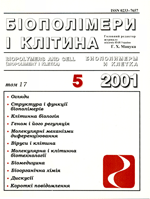Characterization of a novel human gene hUNC93
DOI:
https://doi.org/10.7124/bc.0005CFAbstract
We have identified a novel human gene hUNC93. The expression of human hUNC93 gene was detected in all tested tissues, but placenta, with the highest level observed in heart and brain and the lowest – in liver and leukocytes. The gene was mapped to chromosomal band llqlS. The predicted amino acid sequence of human hUNC93 is related to the UNC93 protein of Caenorhabditis elegans, which play an important role in the muscle contraction.References
Greenwald IS, Horvitz HR. Dominant suppressors of a muscle mutant define an essential gene of Caenorhabditis elegans. Genetics. 1982;101(2):211-25.
Greenwald I, Horvitz HR. A visible allele of the muscle gene sup-10X of C. elegans. Genetics. 1986;113(1):63-72.
Waterston RH, Hirsh D, Lane TR. Dominant mutations affecting muscle structure in Caenorhabditis elegans that map near the actin gene cluster. J Mol Biol. 1984;180(3):473-96.
Greenwald IS, Horvitz HR. unc-93(e1500): A behavioral mutant of Caenorhabditis elegans that defines a gene with a wild-type null phenotype. Genetics. 1980;96(1):147-64.
Zabarovsky ER, Allikmets R, Kholodnyuk I, Zabarovska VI, Paulsson N, Bannikov VM, Kashuba VI, Dean M, Kisselev LL, Klein G. Construction of representative NotI linking libraries specific for the total human genome and for human chromosome 3. Genomics. 1994;20(2):312-6.
Sambrook J, Fritsch EF, Maniatis T. Molecular Cloning: A Laboratory Manual. New York: Cold Spring Harbour Lab. press, 1989.
Protopopov AI, Gizatullin RZ, Vorobieva NV, Protopopova MV, Kiss C, Kashuba VI, Klein G, Kisselev LL, Graphodatsky AS, Zabarovsky ER. Human chromosome 3: high-resolution fluorescence in situ hybridization mapping of 40 unique NotI linking clones homologous to genes and cDNAs. Chromosome Res. 1996;4(6):443-7.
Levin JZ, Horvitz HR. The Caenorhabditis elegans unc-93 gene encodes a putative transmembrane protein that regulates muscle contraction. J Cell Biol. 1992;117(1):143-55.
Grohmann K, Wienker TF, Saar K, Rudnik-Sch?neborn S, Stoltenburg-Didinger G, Rossi R, Novelli G, N?rnberg G, Pfeufer A, Wirth B, Reis A, Zerres K, H?bner C. Diaphragmatic spinal muscular atrophy with respiratory distress is heterogeneous, and one form Is linked to chromosome 11q13-q21. Am J Hum Genet. 1999;65(5):1459-62.

